The decline dumbbell bench press, aka dumbbell decline press, is an upper body workout that engages the lower pec muscles, the triceps, and the anterior deltoid muscles of the shoulders.
Unlike the flat and incline bench press, the angle of the decline bench allows you to dig deep into the lower fibers of your pectoralis major.
No Doubt is one of the best lower chest exercises, but there’s one major problem: the front deltoid likes to dominate the movement, preventing us from getting the maximum benefit.
To overcome these issues, it is preferred to do the exercise on a bench set at 15–30 degrees, declining from flat.
It may seem like a small angle, but it is the proper angle for training your lower pecs and minimizing the effect on the anterior deltoid muscles.
It is also easy to learn and progressively overloaded, so it is used by a beginner or an advanced lifter.
When performed correctly and in good form, this exercise can help give your chest the round, thick look you want.
Want to take your gains to the next level? Discover your daily calorie needs with our free TDEE calculator.
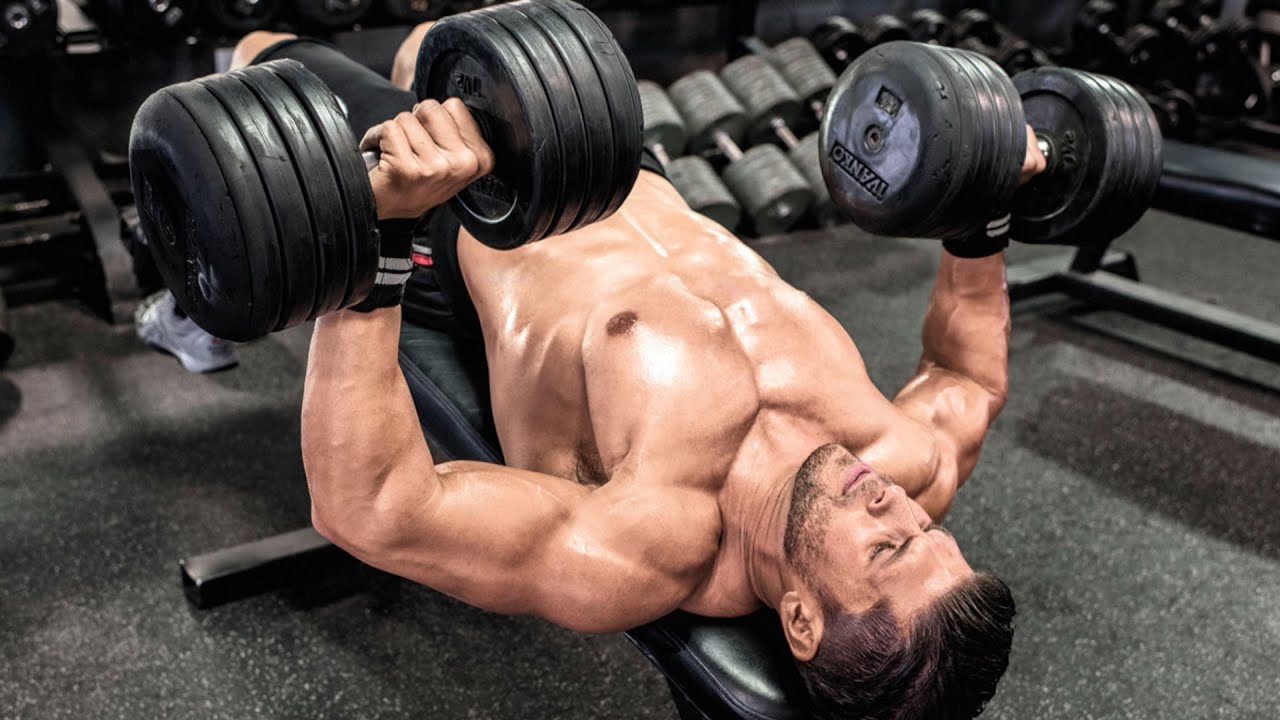
- Decline Dumbbell Press Muscles Worked
- How To Do Decline Dumbbell Press
- Tips For Proper Form
- Sets And Reps
- Best Variations and Modifications of Decline Dumbbell Chest Press
- 1. Decline Hammer-Grip Dumbbell Bench Press
- 2. Dumbbell One-Arm Decline Chest Press
- Dumbbell Decline Press Benefits
- Chest Muscles (Anatomy)
- References
Decline Dumbbell Press Muscles Worked
The decline dumbbell bench press primarily works the major muscles of the lower pectoralis.
As this exercise is primarily used for the lower pectorals, it also places great stress on the inner and upper chest.
The dumbbell decline press involves several synergist muscles,
A handful of other muscles work or play the role of stabilizer muscles, including your
- Biceps brachii,
- Brachialis,
- Triceps brachii,
- Wrist flexors
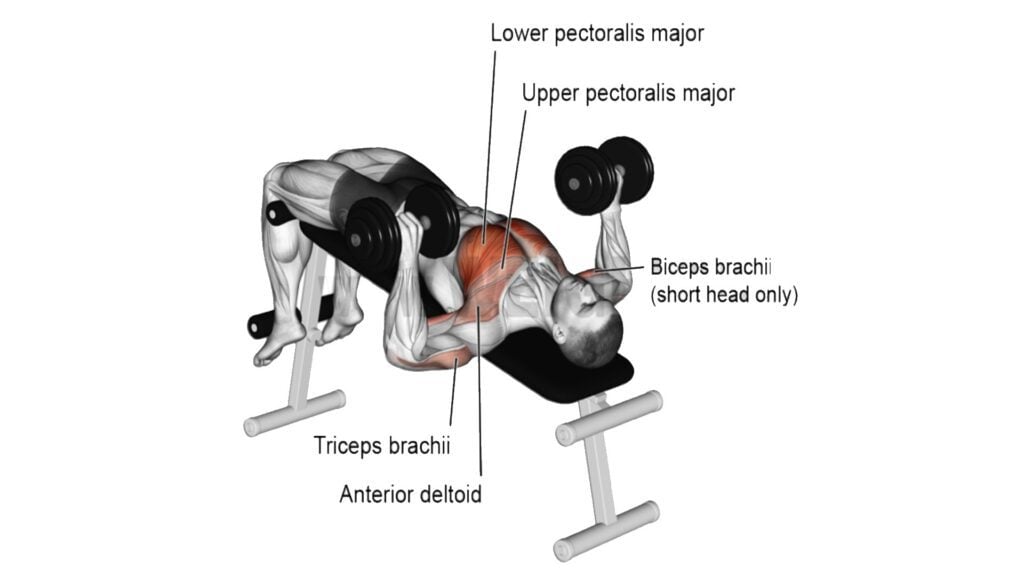
How To Do Decline Dumbbell Press
- Adjust the decline bench to an angle between 15 and 30 degrees. A lower angle (closer to 15 degrees) and a good starting point are often sufficient. Ensure the bench is stable.
- Choose dumbbells you can control with proper form for your desired rep range. It’s better to start lighter and perfect the technique.
- Sit on the higher end of the bench and securely hook your feet/legs under the pads. Make sure you feel stable and won’t slide down during the exercise.
- Place the dumbbells vertically on your thighs, near your knees.
- Carefully lie back onto the bench. As you lie back, use your thighs to help kick the dumbbells up one at a time towards the starting position.
- Press the dumbbells straight up so they are above your lower chest/upper abdomen area. Your arms should be nearly fully extended, but maintain a slight bend in your elbows (don’t lock them out).
- Slowly and under full control, lower the dumbbells in a wide arc outwards and downwards.
- Keep your elbows slightly tucked (45-75 degree) angle relative to your torso. Avoid flaring your elbows out to 90 degrees, as this increases shoulder stress.
- Lower the dumbbells until they are roughly level with your lower chest, or until you feel a comfortable stretch in your pecs.
- Push the dumbbells back up along the same controlled arc path.
- Bring the dumbbells close together at the top, stopping just short of them touching to maintain tension on the chest muscles. Keep that slight bend in your elbows.
Tips For Proper Form
- It is best to set the bench at 15-30 degrees declined for the decline dumbbell press. This protects your shoulders and keeps the tension locked into your lower pectoral fibres.
- Before you lower the weight, actively pull your shoulder blades back and down towards your back pockets, slightly puffing your chest out. This is called scapular retraction and depression.
- Your wrists should stay in line with your forearms, not bent back. A broken wrist position limits force production and can cause discomfort over time.
- Many lifters new to dumbbells press them straight up and down. Instead, visualise lowering the dumbbells outwards slightly, feeling the stretch, and then driving them back up and inwards slightly, focusing on squeezing the pecs together at the top. Think “out and down, up and in.
- Tuck your elbows around 45 degrees from your torso to create a natural pressing path. This keeps tension on your pecs and reduces shoulder strain.
- Make sure that the weights don’t collide with each other at the top of each rep. If they do, you may lose stability within the shoulder and injure yourself.
- Ultimately, your results will depend on your ability to recover adequately from your workouts. You should allow at least 36 to 48 hours of rest before training the same muscle groups again to allow sufficient recovery.
- Ensure you maintain some tension in your abs, and don’t allow your lower back to have an excessive arch.
- It is also important that you focus on your breathing pattern. Proper inhaling and exhaling improve blood circulation and muscle recovery. So, make sure you breathe out when you push the weights up and breathe in when you bring them down to your chest.
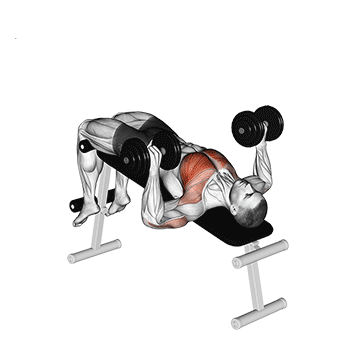
Sets And Reps
Training volume refers to the total amount of work you perform during a workout, including the number of sets, reps, and weights used.
Of course, your fitness journey will determine the number of sets and reps, but here is a great starting point.
Sets
According to the latest scientific evidence, 12–20 weekly sets per muscle group may optimise muscle growth.
- Beginners (with a year or less of training) should aim for about 12 weekly sets.
- An Intermediate trainee (with two to four years of training) can increase the volume to 16 sets per week.
- An advanced trainee (four or more years of training) may be able to get in up to 20 weekly sets.
When a certain amount of volume stops being effective and your progress stalls, you can add sets to increase volume and use that as a driver of renewed progress.
Reps
The best rep ranges and loads to work with.
- For muscle endurance: Aim for 15-20+ reps with moderate resistance.
- For muscle strength: 6–10 reps, with more resistance.
- For muscle hypertrophy (increased muscle size): Aim for 3–4 sets of 8–12 reps, with a moderate to heavy amount of resistance.
It’s best to start with fewer reps and sets first, then increase them as you get stronger.
To Stay Motivated: 150+ Gym Workout Motivational Quotes To Stay Fit
Best Variations and Modifications of Decline Dumbbell Chest Press
The decline dumbbell bench press can be done differently to suit your fitness level.
If you are new to performing a decline dumbbell press, you may want to apply a few modifications to make the exercise easier. One way to counter this problem is to adjust the angle of the bench so that it is completely flat. Another is to use a lighter weight.
If you want a more advanced variation to stimulate different muscle fibers in the chest, try the dumbbell decline hammer press. You can make it more difficult by using heavier weights, but focus on form while doing the same.
1. Decline Hammer-Grip Dumbbell Bench Press
The decline hammer-grip dumbbell press combines two powerful elements: the decline angle (for targeting the lower chest) and the neutral grip (a safe alternative to the pronated grip for shoulder joints).
The neutral grip places the shoulder joint (glenohumeral joint) in a more externally rotated and generally less stressful position than the internally rotated position often needed for a palms-forward grip. Many people find this grip significantly more comfortable in reducing shoulder impingement risk.
This combination creates a biomechanical sweet spot for chest development.
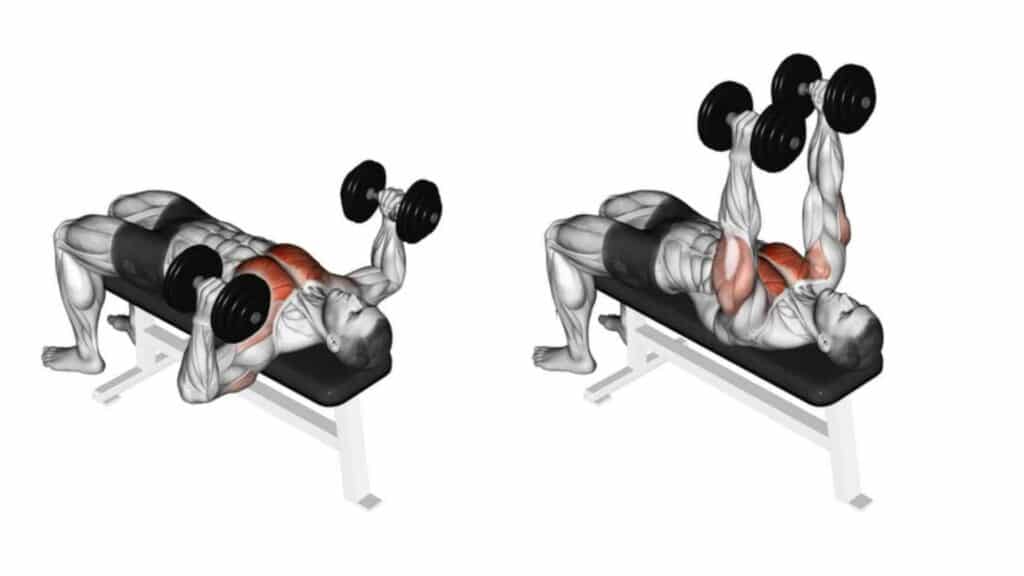
How To Do
- Grab a dumbbell in each hand with a neutral grip and lie on a decline bench.
- When first attempting this variation, start with approximately 10-15% less weight than your standard decline press until you master the movement pattern.
- Sit on the decline bench with dumbbells resting vertically on your thighs (handles pointing up).
- While lying back, bring the weights to your shoulders and rotate to the neutral grip position. Position them at the sides of your lower chest.
- Push the dumbbells upward in a slight arc path. The weights should move both upward and slightly inward.
- At the top, your arms should be fully extended, and the dumbbells should be positioned over your lower chest.
- Maintain a slight bend in the elbows to keep tension on the chest muscles.
- Lower the weights slowly (2-3 second count) until the dumbbells are alongside your lower chest/upper ribcage.
2. Dumbbell One-Arm Decline Chest Press
After coaching clients for over a decade, I’ve discovered that unilateral training is often missing in chest development.
The dumbbell one-arm decline chest press has become one of my go-to exercises for addressing imbalances and breaking through plateaus.
The single-arm setup also engages your core muscles to resist torso rotation, adding a functional stability component.
This unilateral decline press variation is usually performed with lighter weights for moderate to high reps, such as 8–12 reps per set or more, since balance can be an issue.
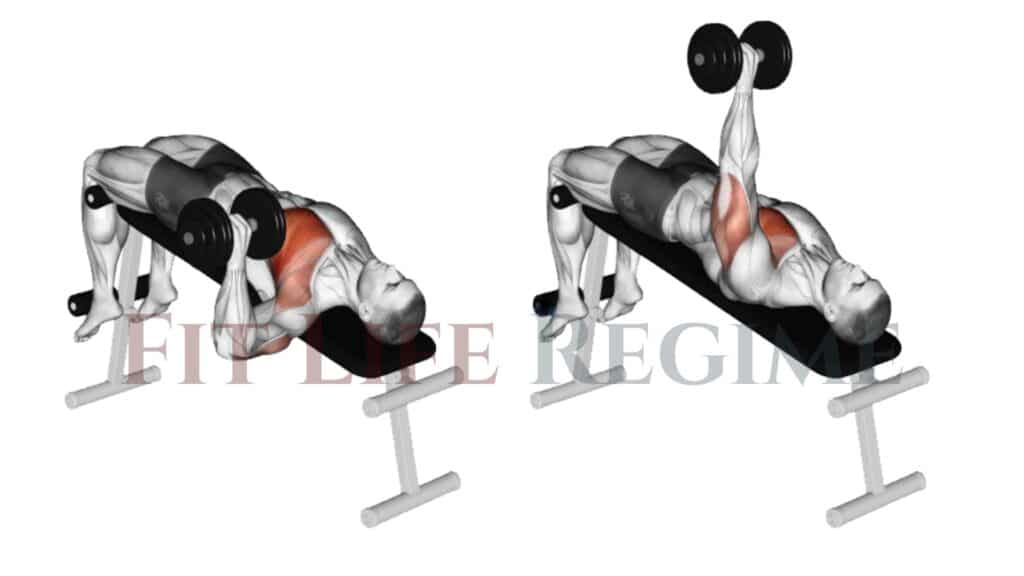
How To Do
- Adjust the bench at around 15–30 degrees of decline.
- Grab a pair of light or moderately heavy dumbbells in one arm.
- Carefully get on the bench and secure your legs.
- Lower yourself slowly and ensure your legs are secured.
- Bring a dumbbell to your side, but avoid flaring your elbows out.
- Take another breath and push the dumbbell up as you engage your chest and triceps.
- Exhale and slowly bring the dumbbell back to your side.
Dumbbell Decline Press Benefits
Several reasons motivate you to decline the dumbbell bench press; I’ve mentioned some below.
- Its primary benefit is its ability to specifically target the lower pectoralis major fibres. When you press from a declined position, the biomechanical angle shifts emphasis to the sternal (lower) portion of your chest.
- The decline angle naturally shifts the load away from the front deltoids and reduces shoulder internal rotation. If you’ve had shoulder pain from traditional benching, the decline dumbbell press often feels more comfortable and safer.
- Dumbbell decline press exercises require more balance than barbells or machines, which can lead to more muscle fiber being recruited.
- Unlike a barbell, which stops when it hits your chest, dumbbells allow each arm to move independently through a potentially deeper range of motion at the bottom (allowing a greater stretch) and can be brought closer together at the top (allowing for a stronger peak contraction). This enhanced ROM can stimulate more muscle fibres.
- Decline DB Press with dumbbell allows unilateral training (training one limb at a time), increases core stability, and improves muscular imbalances.
- Dumbbell decline chest press allows for greater joint safety and stabilisation, and allows the joints to move naturally within their range of motion.
- It affords a greater variety, preventing physical and mental burnout.
Chest Muscles (Anatomy)
The chest muscles primarily comprise the pectoralis major and pectoralis minor.
The pectoralis major is the large, fan-shaped muscle comprising the chest’s bulk. It has two functional subdivisions –the upper and lower regions.
- The upper region is referred to as the clavicular head because of its attachment to the clavicle.
- The lower regions are sometimes called the sternocostal head because of their attachment to the ribs.
Unlike the pectoralis major, the pectoralis minor isn’t visible but is crucial for functional strength and shoulder health. It is situated beneath the pectoralis major, which extends from the middle ribs to the shoulder region.
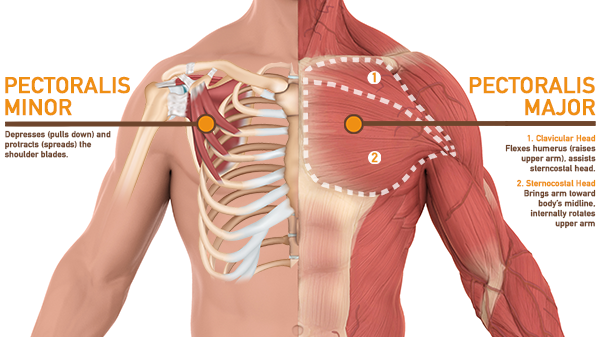
References
- Saeterbakken, A. H., et al. (2017). The effects of bench press variations in competitive athletes on muscle activity and performance.
- Influence of bench angle on upper extremity muscular activation during bench press exercise. Lauver, J. D., Cayot, T. E., & Scheuermann, B. W. (2015). European Journal of Sport Science, 16(3), 309-316. doi:10.1080/17461391.2015.1022605. URL: https://www.tandfonline.com/doi/full/10.1080/17461391.2015.1022605, accessed on 24.08.2020
- An Electromyography Analysis of 3 Muscles Surrounding the Shoulder Joint During the Performance of a Chest Press Exercise at Several Angles. Trebs, A. A., Brandenburg, J. P., & Pitney, W. A. (2010). Journal of Strength and Conditioning Research, 24(7), 1925-1930. doi:10.1519/jsc.0b013e3181ddfae7

Manish is a NASM-certified fitness and nutrition coach with over 10 years of experience in weight lifting and fat loss fitness coaching. He specializes in gym-based training and has a lot of knowledge about exercise, lifting technique, biomechanics, and more.
Through “Fit Life Regime,” he generously shares the insights he’s gained over a decade in the field. His goal is to equip others with the knowledge to start their own fitness journey.
